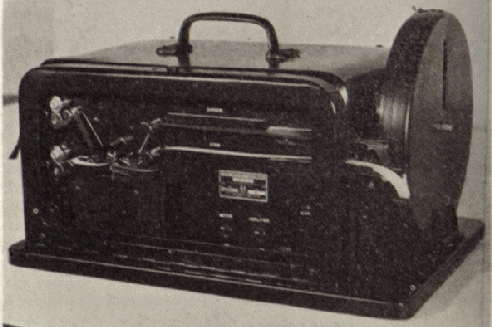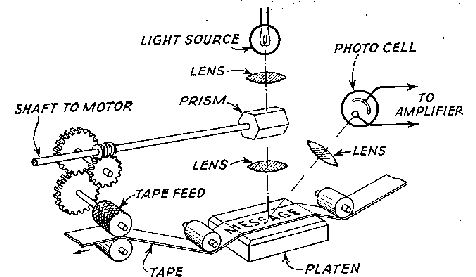|
|
|||||||||||||||||||||||||||
|
Facsimile Tape
The first such eqiupment was assembled in 1931 and was put trough a series of test and demonstrations. The apparatus was in three parts, a typewriter rebuilt to print on strip instead of on a page, a scanner, and a recorder; each with the necessary amplifiers, The original scanner operated on the same priciple as the early´ televission devices, using a disc about 4 inches in diameter with a circular row of holes near its periphery.
Facsimile tape as a distinct method of communication was employed as early 1901 by denison. See Ranger reference. During the latter part of the third decade and up to 1940 consiridation has been given to facsimile tape by quite a number of workers. In general, this work has divided into two groups, mechanicl and photo-optical scanning. The spiral helix and printer bar combination has been employed in both instances for recording purposes. A rather low ratio of intelligence handling to keying speed has handicapped facsimile tape when compared directly with the Baudot type of time code printer. Nevertheless, as stated previously, definitefields of application are available for facsimile tape. Practically all keying arrangements reported on to date are on-off keying of the r-f or audio subcarriers. Ranger (I.R.E. Proc., Vol. 14, No. 2, April, 1926, R. H. Ranger.) Withaker & Collings (RCA Institutes Technical Press, “Radio Facsimile”, pp. 284-293, J. N. Whiteaker, F. C. Collings) Siemens & Halske (Br. Patent 427,257, Siemens & Halske) International Inventions (Br. Patent 380,217, International Inventions) Kleinschmidt (U.S. Patent 2,046,328, E. E. Kleinschmidt et al.) (C) Marius Rensen
|
|
[History] [Historical] [Progress of Wire Facsimile] [Start of Radio Facsimile] [Commercial Point to Point] [Broadcast] [Facsimile Tape] [Comparison of Wire and Radio] [Radio Propagation] [Radio Facsimile Systems] [Scanning Equipment] [Mechanical Scanning] [Recorders] [Synchronizing] [Facsimile Tape] [Machine Design] [Multi Channel] [Color Facsimile] [General] [Conclusion] [Inventors] [Facsimile Makers] [Patents] [Home] [Home] |


